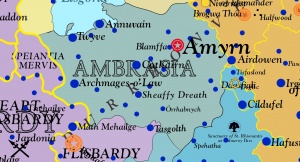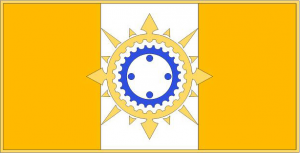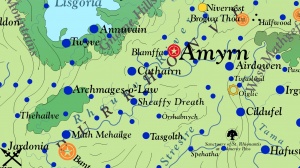Archpatriarchy of Ambrasia

The Archpatriarchy of Ambrasia is a self-governing theocracy headed by a college of heliophants seated in the capital Amyrn. The state cult is the worship of the god Amrulon whose chief temple stands in Amryn with a bevy of lesser temples to the various revered Isxinthion Gods. The Ambrasian love of the ancient sun god Amrulon who is traditionally acknowledged as the father of Arathrax and the head of the Isxinthion Pantheon is widely seen by historians as a rejection of the Arathracian Religion and a determination to establish local rule in the Rhaunve River Valley. The city of Amyrn was the center of the cult of solar gods since the ancient Kemerite Period.
A human inhabitant of Ambrasia is an Ambrasian citizen, but could be of Durrhaunvish or Gonfalese heritage. Most Ambrasians are of Durrhaunvish Moigthe stock with a very large minority of Gonfalese heritage whose language came to dominate since the thirteenth century. Uryalan Gnomes are a noted minority along the shore of Lake Lisgoria. Amyrn and other larger cities are home to significant expatriate communities of Ithradite dwarves.
The City of Amyrn is not only the capital but an important international pilgrimage city, celebrated for its ancient acropolis and Temple of Amrulon Sun God with its famous gilded bronze-tiled rooftop that can be seen glittering on the acropolis from throughout the lower places of the city. Other cities include Archmages-o'-Law, Sheaffy Dreath, Örrhabnych, Cathairn, Blamffa, a suburb or Amyrn, and the gnomish cities of Twyve and Annuvain.

Government
The ruling body of the Archpatriarchy is the Magistral College of Heliophants of Amrulon. They in turn elect an archpatriarch to officiate the rituals of the state cult who resides in the Temple of Amrulon Sun God in Amyrn. The Archpatriarch appoints the various ecclesiastical governors of the various archdioceses and selects new members for the Magistral College from the established clergy, typically those who have completed service as a governor of an archdiocese.
The name 'Ambrasia' derives from an ancient name for the god Amrulon and was the name of the archdiocese during the Yophenthean Empire.
Religion
The state religion of the Archpatriarchy is the indigenous cult of the sun god, Amrulon, whose name is thought to be the root of the name Ambrasia. The religion shares many practices in common with the sun cult of Medibgö and with the Arathracian Religion. As a theocracy, the highest clergy of the church are also the highest officers of the government. While tolerated, Arathracians rarely hold mid level and never high level offices in the government.
Archdioceses of Ambrasia
The archpatriarchy is divided into various archdioceses which are further divided into dioceses.
History
The Archpatriarchy of Ambrasia was established in the twelfth century, centering on the priests and cult of Amyrn. The priests exploited the weakness of the Deavingeal Dynasty whose power in western Pytharnia was collapsing. The priests excised a tax for the use of the Rhaunve River which gave them sufficient support to establish their power. The use of the Rhaunve River has been the cause of conflict with Asbardy which controls the mouth of the Rhaunve River. Ambrasia has also allowed the Ithradite dwarves to use the river to access the sea for trade and diplomacy.
The original Ambrasians were of Moigthe stock and spoke the now extinct Ambrosian Language which is one of several Yophenthean Languages. Their language and culture were overtaken by the immigration of Medibgösk exiles in the thirteenth century which introduced the Medibgösk Language that eventually became the Gonfalese Language, becoming the dominant tongue of the country. Prior to the Ambrasian Language, the Rhaunvish Language was spoken which is related laterally to Classical Yophenthean.
Politics
The Archpatriarchy has a strong, ongoing defensive treaty with the Commonwealth of the Ithrads which has chilled the imperial ambitions of Magdala and Asbardy. The Ithradite dwarves are well-known for their powerful heavy infantry. The Ambrasians rely upon the dwarves for gold essential for their cult practices and the dwarves in turn have the advantage of a favorable buffer state to separate them from Asbardy. Modern Ambrasia has reciprocal agreements with Asbardy concerning the use of the Rhaunve River that enable Asbardian river shipping the use of the river in Ambrasia and in turn allows Ambrasian and Ithradite river shipping through the mouth of the river to the Sea of Asbardy. The Ithradite Dwarves are permitted access directly and indirectly by the Rhaunve River to the sea as part of the trade agreements.
Economy
Ambrasia is famous for golden wines, fine pastries, and sweet cheeses. The chief livestock are sheep and cows. Wool is an important product and Ambrasian wool is rated fine. The city of Amyrn relies on income from visiting pilgrims to the Temple of Amrulon Sun God and is famous for selling small gold-plated likenesses of the temple and of the sun god.
Culture
The strongest present influence is the Gonfalese culture, but many customs and practices from ancient Ambrasian culture persist and both blend to form the the uniquely rich Ambrasian Civilization. While the Ambrasian Language is no longer spoken, except by scholars, many families and towns are proud of their Ambrasian heritage. The state cult of the sun god Amrulon is an essential component that ties together Gonfalese and Ambrasian cultures.
See Also
- Ambrasia
- Amyrn
- Durrhaunve
- Isbajath of Sulmayand the Valiant
- List of the Archdioceses of Ambrasia
- Magisterium of Heliophants of Amrulon
| This article is a stub. It requires further development by the creator. |
